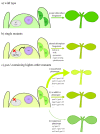GUN1 and Plastid RNA Metabolism: Learning from Genetics
- PMID: 33081381
- PMCID: PMC7602965
- DOI: 10.3390/cells9102307
GUN1 and Plastid RNA Metabolism: Learning from Genetics
Abstract
GUN1 (genomes uncoupled 1), a chloroplast-localized pentatricopeptide repeat (PPR) protein with a C-terminal small mutS-related (SMR) domain, plays a central role in the retrograde communication of chloroplasts with the nucleus. This flow of information is required for the coordinated expression of plastid and nuclear genes, and it is essential for the correct development and functioning of chloroplasts. Multiple genetic and biochemical findings indicate that GUN1 is important for protein homeostasis in the chloroplast; however, a clear and unified view of GUN1's role in the chloroplast is still missing. Recently, GUN1 has been reported to modulate the activity of the nucleus-encoded plastid RNA polymerase (NEP) and modulate editing of plastid RNAs upon activation of retrograde communication, revealing a major role of GUN1 in plastid RNA metabolism. In this opinion article, we discuss the recently identified links between plastid RNA metabolism and retrograde signaling by providing a new and extended concept of GUN1 activity, which integrates the multitude of functional genetic interactions reported over the last decade with its primary role in plastid transcription and transcript editing.
Keywords: GUN1; RNA polymerase; retrograde signaling; transcript accumulation; transcript editing.
Conflict of interest statement
The authors declare no conflict of interest.
Figures


Similar articles
-
The Role of Tetrapyrrole- and GUN1-Dependent Signaling on Chloroplast Biogenesis.Plants (Basel). 2021 Jan 21;10(2):196. doi: 10.3390/plants10020196. Plants (Basel). 2021. PMID: 33494334 Free PMC article. Review.
-
The plastid transcription machinery and its coordination with the expression of nuclear genome: Plastid-Encoded Polymerase, Nuclear-Encoded Polymerase and the Genomes Uncoupled 1-mediated retrograde communication.Philos Trans R Soc Lond B Biol Sci. 2020 Jun 22;375(1801):20190399. doi: 10.1098/rstb.2019.0399. Epub 2020 May 4. Philos Trans R Soc Lond B Biol Sci. 2020. PMID: 32362266 Free PMC article. Review.
-
GUN1 Controls Accumulation of the Plastid Ribosomal Protein S1 at the Protein Level and Interacts with Proteins Involved in Plastid Protein Homeostasis.Plant Physiol. 2016 Mar;170(3):1817-30. doi: 10.1104/pp.15.02033. Epub 2016 Jan 28. Plant Physiol. 2016. PMID: 26823545 Free PMC article.
-
GUN1 interacts with MORF2 to regulate plastid RNA editing during retrograde signaling.Proc Natl Acad Sci U S A. 2019 May 14;116(20):10162-10167. doi: 10.1073/pnas.1820426116. Epub 2019 Apr 15. Proc Natl Acad Sci U S A. 2019. PMID: 30988197 Free PMC article.
-
GENOMES UNCOUPLED PROTEIN1 binds to plastid RNAs and promotes their maturation.Plant Commun. 2024 Dec 9;5(12):101069. doi: 10.1016/j.xplc.2024.101069. Epub 2024 Aug 22. Plant Commun. 2024. PMID: 39169625 Free PMC article.
Cited by
-
Perturbation of protein homeostasis brings plastids at the crossroad between repair and dismantling.PLoS Genet. 2023 Jul 7;19(7):e1010344. doi: 10.1371/journal.pgen.1010344. eCollection 2023 Jul. PLoS Genet. 2023. PMID: 37418499 Free PMC article.
-
QTL mapping and candidate gene analysis reveal two major loci regulating green leaf color in non-heading Chinese cabbage.Theor Appl Genet. 2024 Apr 15;137(5):105. doi: 10.1007/s00122-024-04608-x. Theor Appl Genet. 2024. PMID: 38622387
-
The PUB4 E3 Ubiquitin Ligase Is Responsible for the Variegated Phenotype Observed upon Alteration of Chloroplast Protein Homeostasis in Arabidopsis Cotyledons.Genes (Basel). 2021 Sep 6;12(9):1387. doi: 10.3390/genes12091387. Genes (Basel). 2021. PMID: 34573369 Free PMC article.
-
The Role of Tetrapyrrole- and GUN1-Dependent Signaling on Chloroplast Biogenesis.Plants (Basel). 2021 Jan 21;10(2):196. doi: 10.3390/plants10020196. Plants (Basel). 2021. PMID: 33494334 Free PMC article. Review.
-
A Holistic Investigation of Arabidopsis Proteomes Altered in Chloroplast Biogenesis and Retrograde Signalling Identifies PsbO as a Key Regulator of Chloroplast Quality Control.Plant Cell Environ. 2025 Aug;48(8):6373-6396. doi: 10.1111/pce.15611. Epub 2025 May 14. Plant Cell Environ. 2025. PMID: 40366233 Free PMC article.
References
-
- Bramley P.M. Carotenoids in Photosynthesis. Springer; Berlin/Heidelberg, Germany: 1993. Inhibition of carotenoid biosynthesis; pp. 127–159.
Publication types
MeSH terms
Substances
LinkOut - more resources
Full Text Sources

